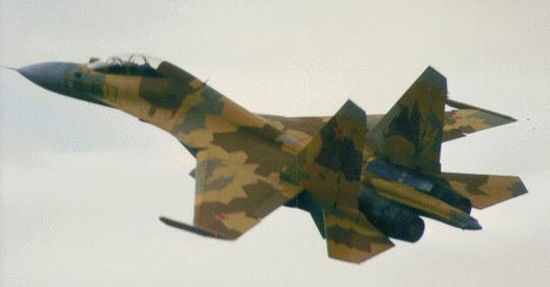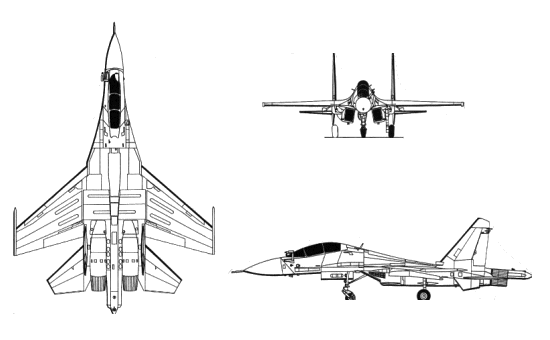|
||||||||||
|
|
||||||||||
|
||||||||||
|
|
||||||||||
 - -
 - -
|
|

|
Sukhoi Su-30 ASCC codename: Flanker Multi-Role Fighter |
|
DESCRIPTION:
Based on the two-seat Su-27UB trainer and originally known as the Su-27PU, the Sukhoi Su-30 is a long-range precision-attack fighter similar to the F-15E Eagle series. Although retaining the air-to-air interceptor capabilities of the Su-27, the early Su-30 and Su-30K models are optimized for long-endurance missions of 10 hours or so. These aircraft are also fitted with a radiolocation system allowing the positions of up to 10 to ve transmitted to four other aircraft simultaneously. This feature makes the Su-30 suitable as a tactical fighter leader designating targets to be attacked by other aircraft. These variants were later joined by the multi-role Su-30M that adds precision ground attack capability while carrying a range of advanced guided bombs and missiles. Sukhoi has also actively marketed an export model, the Su-30MK, that has been purchased in large numbers by India (Su-30MKI) and China (Su-30MKK, Su-30MK2). India's aircraft are generally more capable than any other variant of the Su-30 and include canards as well as vectored thrust nozzles for improved maneuverability, a better radar, and more advanced avionics from Indian and Western sources. Current plans call for the Indian Air Force to acquire 280 units of Su-30MKI, and 140 of these are to be license built at Hindustan Aeronotics Limited within India. Indonesia has also shown interest in the Su-30MK, but acquisition plans have been significantly curtailed due to the nation's political and economic turmoil. Other export sales have come from Asian and Middle Eastern countries like Malaysia, Vietnam, and Algeria while Syria has also expressed interest. Perhaps the most controversial customer is Venezuela that ordered the advanced fighter to spite the US over a lack of support for the Venezuelan F-16 fleet. In Russian service, the Su-30 has supplemented and replaced many older MiG-31 and Su-27 intereceptors and remains the most advanced fighter in the Russian Air Force. Several upgrades to the existing fleet are planned to maintain the aircraft's capabilities against competing combat planes until a next-generation fighter becomes available by 2020.
Data below for Su-30M and Su-30MKI |
|
| HISTORY: | |
| First Flight | 1989 |
|
Service Entry
|
1992
|
| CREW: |
two: pilot, weapons systems officer
|
|
ESTIMATED COST:
|
$34 million
|
| AIRFOIL SECTIONS: | |
| Wing Root | unknown |
|
Wing Tip
|
unknown
|
| DIMENSIONS: | |
| Length | 71.92 ft (21.94 m) |
| Wingspan | 48.17 ft (14.70 m) |
| Height | 20.83 ft (6.36 m) |
| Wing Area | 666 ft² (62.0 m²) |
|
Canard Area
|
not applicable
|
| WEIGHTS: | |
| Empty | 32,020 lb (17,700 kg) |
| Normal Takeoff |
(Su-30M) 52,910 lb (24,000 kg) (Su-30MKI) 56,590 lb (25,670 kg) |
| Max Takeoff |
(Su-30M) 73,855 lb (33,500 kg) (Su-30MKI) 74,955 lb (34,000 kg) |
| Fuel Capacity | 20,725 lb (9,400 kg) |
|
Max Payload
|
17,640 lb (8,000 kg)
|
| PROPULSION: | |
| Powerplant | two Saturn/ Lyul'ka AL-31F afterburning turbofans |
| Thrust |
55,114 lb (245.16 kN)
|
| PERFORMANCE: | |
| Max Level Speed |
at altitude: 1,320 mph (2,125 km/h) at 32,780 ft (10,000 m), Mach 2.3 at sea level: unknown cruise speed: 860 mph (1,380 km/h) at 32,780 ft (10,000 m) |
| Initial Climb Rate | 45,235 ft (13,800 m) / min |
| Service Ceiling | 57,360 ft (17,500 m) |
| Range |
typical: 1,620 nm (3,000 km) ferry: 3,770 nm (6,990 km) |
| g-Limits |
+9
|
| ARMAMENT: | |
| Gun | one 30-mm GSh-301 cannon (149 rds) |
| Stations | ten external hardpoints and two wingtip rails |
| Air-to-Air Missile | R-33/AA-9 Amos, up to six R-27R/AA-10A Alamo, up to six R-27T/AA-10B Alamo, up to two R-27P/AA-10C Alamo, up to six R-73/AA-11 Archer, up to six R-77/AA-12 |
| Air-to-Surface Missile | up to six Kh-29/AS-14 Kedge, up to four Kh-31/AS-17 Krypton, up to two Kh-59/AS-18 Kazoo |
| Bomb | up to six KAB-500KR laser-guided, up to three KAB-1500KR laser-guided, up to eight FAB-500 GP, up to 28 OFAB-250-270 GP, up to eight RBK-500 cluster |
| Other |
up to four S-8/S-13 rocket pods, APK-9 datalink pod (Su-30MKI) EL/L-8222 radar jammer pod, LITENING laser targeting pod, High Accuracy Direction Finding (HADF) pod, flight refuelling pod |
| KNOWN VARIANTS: | |
| Su-27PU | Original designation of the Su-30 |
| Su-30 'Flanker-C' | Two-seat long-range, long-endurance interceptor based on the Su-27UB |
| Su-30K | Improved Su-30 with in-flight refueling capability, strengthened structure, and greater range |
| Su-30KI | Conflicting descriptions exist, but the most likely appears to be a single-seat Su-30K model for Indonesia with several features of the Su-30MK; cancelled |
| Su-30KN | Upgrade available for the Su-30 and Su-30K |
| Su-30M | Upgraded two-seat multi-role variant of the Su-30 with ground attack capability and able to carry a wide range of air-to-ground weapons |
| Su-30MK | Export version of the Su-30M |
| Su-30M2 | Upgraded version of the Su-30MK equipped with canards and thrust vectoring nozzles |
| Su-30MKA | Su-30M export model for Algeria |
| Su-30MKK 'Flanker-G' | Su-30M export model for the Chinese Air Force with improved avionics; approximately 150 built in Russia or license built in China with another 170 planned |
| Su-30MK2 | Model similar to the Su-30MKK but optimized for maritime patrol and armed with anti-ship missiles; 24 built for the Chinese Navy and 11 for Indonesia |
| Su-30MK2V | Export variant of the Su-30M for Vietnam based on the Su-30MK2; 4 built |
| Su-30MK3 | Chinese model similar to the Su-30MK2 but equipped with the Zhuk MSE radar for use with the Kh-59MK anti-ship missile; may have been cancelled |
| Su-30MKI 'Flanker-H' | Su-30M export model for India with improved avionics and enhanced multi-role capabilities, all to be upgraded with canards and thrust vectoring nozzles; 230 to be built in Russia or license built in India |
| Su-30MKM | Su-30M export model for Malaysia with the same airframe, thrust vectoring, and canards as the Su-30MKI but different avionics; 18 ordered |
| Su-30MKV |
Su-30M export model for Venezuela based on the Su-30MK2
|
| KNOWN COMBAT RECORD: |
none
|
| KNOWN OPERATORS: |
Algeria, Al Quwwat al Jawwawiya al Jaza'eriya (Algerian Air Force) China, Zhongkuo Shenmin Taifang Tsunputai (People's Liberation Army Air Force) China (People's Liberation Army Navy) India, Bharatiya Vayu Sena (Indian Air Force) Indonesia, Tentara Nasional Indonesia - Angkatan Udara (Indonesian Air Force) Malaysia, Tentera Udara Diraja Malaysia (Royal Malaysian Air Force) Russia, Voyenno Vozdushniye Sili (Russian Air Force) Venezuela, Fuerza Aérea Venezolana (Venezuelan Air Force) Vietnam, Khong Quan Nhan Dan Viet Nam (Vietnam People's Army Air Force) |
|
3-VIEW SCHEMATIC:

|
|
SOURCES:
|
|


|
Aircraft | Design | Ask Us | Shop | Search |

|
|
| About Us | Contact Us | Copyright © 1997-2023 | |||
|
|
|||